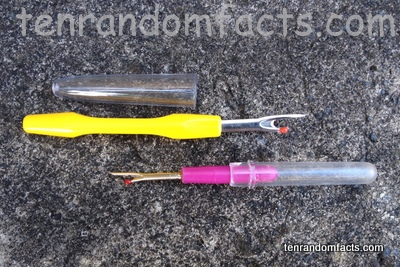What are the true origins of a seam ripper?
- Seam rippers are an item designed for breaking or undoing sewn stitches, often on seams.
- A seam ripper is also known as a ‘stitch unpicker’, ‘quick unpic’ and a ‘quick unpick’.
- Typically, seam rippers have two spokes, one sharp and the other blunt, connected by a handle, while the intersection is usually a sharp blade.
- When using seam rippers, the sharp point is placed underneath the stitch and the device is pulled upwards, causing the thread to touch the blade and be cut by it; while the blunt or ball point is designed to protect the fabric that the tool comes in contact with.
- Seam rippers where probably invented some time in the late 1800s, and one of the earliest patents for a similar tool was a thimble that had the addition of a small knife that was patented in the United States by W Miller in 1883, that was used to rip threads in a similar way; while a later patent exists for a tool designed for the sole purpose of ripping seams, in 1898 by John Fisher from Canada.
- Seam rippers typically range from 7 to 15 centimetres (3 to 6 inches) in length and are held with one’s fingers.
- Although its primary purpose is to cut stitches or open up a sew seam, seam rippers can also be used to undo threads or stitches that have been incorrectly placed.
- Seam rippers generally come with a lid, or can be inserted into a case for safe storage.
- Seam rippers can be used to slit open button holes; to easily trim small, excess material; or to detach buttons from fabric.
- Seam rippers come in a variety of shapes and colours, and the blade is typically made of metal, and the usually have a wooden, plastic or metal handle.
Bibliography:
Fisher, J 1898, ‘John Edward Fisher’, US604675 A, 24 May, p. 1, Google Patents, Google
Miller, W 1883, ‘Combined Thimble and Thread-Cutter’, US273380 A, 6 March, p. 1, Google Patents, Google
Seam Ripper, 2013, Wikipedia, http://en.wikipedia.org/wiki/Seam_ripper
What is a Seam Ripper, 2015, WiseGEEK, http://www.wisegeek.com/what-is-a-seam-ripper.htm






